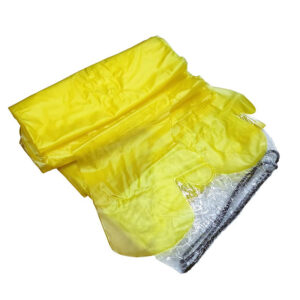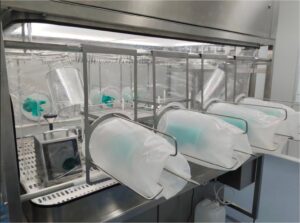In the world of cleanroom technology, proper documentation is crucial for maintaining the highest standards of cleanliness and efficiency. One essential piece of equipment in this realm is the LAF Garment Cabinet, a vital component in ensuring that personnel entering cleanroom environments are properly attired and free from contaminants. The installation process for these cabinets is a critical step that requires meticulous attention to detail and comprehensive documentation.
The LAF Garment Cabinet Installation Documentation is a crucial set of guidelines that outline every step of the installation process, from initial site preparation to final testing and validation. This documentation serves as a roadmap for technicians, ensuring that each cabinet is installed correctly and consistently across different facilities. It also provides a valuable reference for future maintenance and troubleshooting.
As we delve into the intricacies of LAF Garment Cabinet Installation Documentation, we'll explore the various components that make up this essential guide. From technical specifications to safety protocols, each element plays a vital role in the successful implementation of these critical cleanroom fixtures.
The importance of proper documentation in the installation of LAF Garment Cabinets cannot be overstated. It serves as a cornerstone for quality assurance, regulatory compliance, and operational efficiency. As we examine the various aspects of this documentation, we'll uncover the key elements that contribute to its effectiveness and importance in the cleanroom industry.
Comprehensive and accurate LAF Garment Cabinet Installation Documentation is essential for ensuring the proper functionality, safety, and compliance of cleanroom environments.
What are the key components of LAF Garment Cabinet Installation Documentation?
The LAF Garment Cabinet Installation Documentation is a comprehensive guide that encompasses various crucial elements. At its core, it provides a detailed roadmap for the entire installation process, ensuring that each step is executed with precision and care.
Key components typically include site preparation requirements, equipment specifications, step-by-step installation procedures, safety protocols, and testing and validation guidelines. These elements work together to create a cohesive document that serves as both a guide for installers and a reference for facility managers.
One of the most critical aspects of this documentation is the detailed technical specifications of the LAF Garment Cabinet. This includes dimensions, materials, airflow requirements, and electrical specifications. Such information is vital for ensuring that the cabinet is compatible with the existing cleanroom infrastructure and meets all necessary standards.
Proper LAF Garment Cabinet Installation Documentation must include comprehensive technical specifications to ensure seamless integration with existing cleanroom systems and compliance with industry standards.
| Component | Description | Importance |
|---|---|---|
| Site Preparation | Guidelines for preparing the installation area | Ensures proper fit and functionality |
| Technical Specifications | Detailed equipment specifications | Guarantees compatibility and performance |
| Installation Procedures | Step-by-step installation guide | Ensures consistent and correct installation |
| Safety Protocols | Safety guidelines for installation and operation | Protects personnel and maintains cleanroom integrity |
| Testing and Validation | Procedures for verifying proper installation and operation | Confirms compliance with standards and regulations |
In conclusion, the key components of LAF Garment Cabinet Installation Documentation form a comprehensive guide that ensures the successful implementation of these critical cleanroom fixtures. By covering all aspects of the installation process, from preparation to validation, this documentation plays a vital role in maintaining the high standards required in cleanroom environments.
How does proper documentation contribute to regulatory compliance?
Proper documentation in the installation of LAF Garment Cabinets plays a crucial role in ensuring regulatory compliance within cleanroom environments. In industries such as pharmaceuticals, biotechnology, and electronics manufacturing, adherence to strict regulatory standards is non-negotiable.
The YOUTH brand understands that comprehensive installation documentation serves as evidence of compliance with industry regulations and standards. It provides a clear audit trail that demonstrates the proper installation and validation of equipment, which is essential for passing regulatory inspections and maintaining certifications.
Detailed documentation also helps in tracking and managing changes over time. As regulations evolve or equipment is modified, having a robust documentation system allows facilities to easily update their processes and demonstrate ongoing compliance.
Comprehensive LAF Garment Cabinet Installation Documentation is a critical tool for demonstrating regulatory compliance and maintaining cleanroom certifications.
| Regulatory Aspect | Documentation Requirement | Compliance Benefit |
|---|---|---|
| Installation Process | Detailed installation procedures | Demonstrates adherence to manufacturer guidelines |
| Equipment Specifications | Technical details and performance criteria | Ensures equipment meets regulatory standards |
| Validation Records | Test results and performance verification | Proves equipment functions as intended |
| Change Management | Documentation of modifications and updates | Shows ongoing compliance with evolving regulations |
In conclusion, proper documentation is not just a bureaucratic necessity but a fundamental component of regulatory compliance in cleanroom environments. It provides tangible evidence of adherence to standards, facilitates continuous improvement, and helps maintain the integrity of cleanroom operations.
What role does documentation play in quality assurance?
Quality assurance is a critical aspect of cleanroom operations, and documentation plays a pivotal role in maintaining high standards. The LAF Garment Cabinet Installation Documentation serves as a cornerstone in this process, ensuring that every installation meets the same rigorous quality criteria.
By providing a standardized set of instructions and specifications, the documentation minimizes variability in the installation process. This consistency is crucial for maintaining the integrity of the cleanroom environment and ensuring that each LAF Garment Cabinet functions optimally.
Furthermore, the documentation serves as a benchmark for quality checks. It outlines the expected performance parameters and provides a framework for testing and validation. This allows quality assurance teams to verify that each installation meets the required standards and performs as intended.
Detailed LAF Garment Cabinet Installation Documentation is essential for maintaining consistent quality standards across multiple cleanroom installations and facilitating effective quality assurance processes.
| Quality Assurance Aspect | Documentation Role | Impact on Quality |
|---|---|---|
| Standardization | Provides uniform installation procedures | Ensures consistency across installations |
| Performance Benchmarking | Outlines expected performance parameters | Facilitates accurate quality checks |
| Troubleshooting | Offers reference for identifying issues | Enables quick resolution of quality concerns |
| Continuous Improvement | Allows for documentation of best practices | Supports ongoing quality enhancement |
In conclusion, the role of documentation in quality assurance cannot be overstated. It provides the foundation for maintaining consistent, high-quality installations of LAF Garment Cabinets, which is crucial for the overall performance and compliance of cleanroom environments.
How does installation documentation support maintenance and troubleshooting?
Comprehensive LAF Garment Cabinet Installation Documentation is not just crucial for the initial setup; it also plays a vital role in ongoing maintenance and troubleshooting. This documentation serves as a valuable reference for technicians and facility managers long after the initial installation is complete.
The detailed specifications and procedures outlined in the documentation provide a baseline for regular maintenance activities. Technicians can refer to these documents to ensure that they are following the correct procedures and using the appropriate tools and materials during routine maintenance tasks.
In the event of equipment malfunction or performance issues, the installation documentation becomes an invaluable troubleshooting resource. It allows technicians to compare current performance against the original specifications and installation parameters, helping to identify potential causes of issues more quickly and accurately.
Well-structured LAF Garment Cabinet Installation Documentation serves as a crucial resource for efficient maintenance and effective troubleshooting, minimizing downtime and ensuring optimal performance of cleanroom equipment.
| Aspect | Documentation Benefit | Operational Impact |
|---|---|---|
| Maintenance Schedules | Provides guidelines for regular upkeep | Ensures timely and proper maintenance |
| Spare Parts Information | Lists required components and specifications | Facilitates quick and accurate parts replacement |
| Troubleshooting Guides | Offers step-by-step problem-solving procedures | Reduces equipment downtime |
| Performance Baselines | Establishes normal operating parameters | Aids in identifying and addressing performance deviations |
In conclusion, installation documentation is a critical tool that extends far beyond the initial setup phase. By supporting ongoing maintenance and troubleshooting efforts, it helps ensure the long-term reliability and performance of LAF Garment Cabinets in cleanroom environments.
What are the essential elements of effective installation documentation?
Effective LAF Garment Cabinet Installation Documentation comprises several essential elements that work together to provide a comprehensive guide for installers, operators, and maintenance personnel. These elements ensure that the documentation is not only informative but also practical and easy to use.
One of the most crucial elements is clarity. The documentation must be written in clear, concise language that can be easily understood by all relevant personnel. Technical jargon should be explained, and complex procedures should be broken down into manageable steps.
Visual aids such as diagrams, photographs, and flowcharts are also essential. These visual elements can often convey information more effectively than text alone, particularly when it comes to complex assembly procedures or spatial relationships within the cleanroom.
Effective LAF Garment Cabinet Installation Documentation must balance technical depth with clarity and accessibility, utilizing visual aids and structured formats to ensure comprehensive understanding and practical application.
| Documentation Element | Purpose | Impact on Effectiveness |
|---|---|---|
| Clear Language | Ensures understanding across all skill levels | Reduces errors and misinterpretations |
| Visual Aids | Illustrates complex procedures and setups | Enhances comprehension and reduces installation time |
| Structured Format | Organizes information logically | Improves ease of use and reference |
| Comprehensive Checklists | Ensures all steps are completed | Reduces oversight and improves installation quality |
In conclusion, the effectiveness of LAF Garment Cabinet Installation Documentation hinges on its ability to convey complex information clearly and comprehensively. By incorporating these essential elements, the documentation becomes an invaluable tool for ensuring proper installation, operation, and maintenance of these critical cleanroom components.
How does digital documentation enhance the installation process?
In the modern era of cleanroom technology, digital documentation is revolutionizing the way LAF Garment Cabinet installations are conducted and managed. The shift from traditional paper-based manuals to digital formats offers numerous advantages that enhance the overall installation process.
Digital documentation allows for real-time updates and revisions, ensuring that installers always have access to the most current information. This is particularly crucial in the fast-paced world of cleanroom technology, where specifications and best practices can evolve rapidly.
Moreover, digital formats enable interactive features such as searchable content, hyperlinks between related sections, and embedded multimedia. These features can significantly improve the user experience, making it easier for technicians to quickly find the information they need during the installation process.
Digital LAF Garment Cabinet Installation Documentation offers enhanced accessibility, updatability, and interactivity, leading to more efficient and accurate installations in cleanroom environments.
| Digital Feature | Benefit | Impact on Installation Process |
|---|---|---|
| Real-time Updates | Ensures access to latest information | Reduces errors due to outdated procedures |
| Searchable Content | Enables quick information retrieval | Speeds up installation and troubleshooting |
| Multimedia Integration | Provides visual and audio guidance | Enhances understanding of complex procedures |
| Remote Access | Allows off-site expert consultation | Facilitates quick resolution of installation challenges |
In conclusion, the adoption of digital documentation for LAF Garment Cabinet installations represents a significant advancement in cleanroom technology. By leveraging the power of digital tools, facilities can ensure more efficient, accurate, and up-to-date installation processes, ultimately contributing to the overall quality and performance of their cleanroom environments.
What are the best practices for creating and maintaining installation documentation?
Creating and maintaining effective LAF Garment Cabinet Installation Documentation requires a systematic approach and ongoing commitment. Best practices in this area focus on ensuring the documentation remains accurate, comprehensive, and user-friendly throughout its lifecycle.
One key practice is to involve multiple stakeholders in the documentation process. This includes not only technical writers but also engineers, installers, and end-users. By incorporating diverse perspectives, the resulting documentation is more likely to address all relevant aspects of the installation process.
Regular review and update cycles are also crucial. As Documentation requirements evolve and equipment specifications change, the documentation must be systematically reviewed and updated to reflect these changes. This ensures that it remains a reliable resource for all users.
Effective LAF Garment Cabinet Installation Documentation requires collaborative creation, regular updates, and a user-centric approach to ensure its ongoing relevance and utility in cleanroom environments.
| Best Practice | Description | Impact on Documentation Quality |
|---|---|---|
| Stakeholder Involvement | Includes input from various experts and users | Ensures comprehensive and practical content |
| Regular Review Cycles | Schedules periodic documentation reviews | Maintains accuracy and relevance over time |
| User Feedback Integration | Incorporates user experiences and suggestions | Improves usability and addresses real-world needs |
| Version Control | Maintains clear record of document changes | Facilitates tracking and referencing of updates |
In conclusion, adhering to these best practices in creating and maintaining LAF Garment Cabinet Installation Documentation ensures that it remains a valuable, up-to-date resource. This commitment to quality documentation ultimately contributes to the safety, efficiency, and compliance of cleanroom operations.
Proper documentation is the bedrock upon which successful LAF Garment Cabinet installations are built. Throughout this exploration of LAF Garment Cabinet Installation Documentation, we've uncovered the multifaceted role that comprehensive documentation plays in ensuring the efficiency, safety, and compliance of cleanroom environments.
From serving as a crucial tool for regulatory compliance to supporting ongoing maintenance and troubleshooting efforts, well-crafted documentation touches every aspect of the LAF Garment Cabinet's lifecycle. The shift towards digital documentation has further enhanced these benefits, offering real-time updates and interactive features that streamline the installation process.
The key components we've discussed, including detailed technical specifications, clear installation procedures, and comprehensive testing protocols, work in concert to create a robust framework for successful implementations. By adhering to best practices in documentation creation and maintenance, facilities can ensure that their LAF Garment Cabinet installations meet the highest standards of quality and performance.
As cleanroom technology continues to evolve, the importance of thorough and accurate documentation will only grow. It serves not just as a guide for current operations but as a foundation for future innovations and improvements in cleanroom practices.
In conclusion, LAF Garment Cabinet Installation Documentation is far more than a mere bureaucratic requirement. It is a vital tool that underpins the safety, efficiency, and reliability of cleanroom operations. By recognizing its importance and investing in its quality, facilities can ensure they are well-equipped to meet the challenges of modern cleanroom technology and maintain the highest standards of cleanliness and contamination control.
External Resources
A Guide to Different Requirements Documentation (With Types) – This article explains what requirements documentation is, its importance, and the various types of requirements documents, including Functional Requirements Documents, Business Requirements Documents, and Technical Requirements Documents.
What Are Common Requirements Documentation Formats? – This resource details common formats for documenting requirements, such as Business Requirements Documents, Functional Requirements Documents, System Requirements Specification, and User Stories, highlighting their unique benefits and contexts.
SAMPLE BUSINESS REQUIREMENTS DOCUMENT TEMPLATE – This is a template for a Business Requirements Document, providing a structured format to detail project requirements, including functional and non-functional requirements, priority levels, and responsible personnel.
Documentation Requirements – JF Part B – Noridian – Although focused on medical documentation, this page provides insights into the importance of detailed documentation requirements, including specific details needed for submission and review processes, which can be generalized to other fields.
Business Requirements Document (BRD): A Comprehensive Guide – This comprehensive guide explains the purpose and components of a Business Requirements Document, including project goals, needs statements, financial statements, and other critical elements necessary for project success.
Functional Requirements Document (FRD): Definition and Examples – This resource explains the purpose and structure of a Functional Requirements Document, including examples of how it defines the system's functionality and user interactions.
Technical Requirements Document: A Detailed Guide – This guide outlines the components of a Technical Requirements Document, such as platform, hardware, and software requirements, and how it supports the development and testing phases of a project.
The Importance of Requirements Documentation in Project Management – This article discusses the broader implications of requirements documentation in project management, including stakeholder communication, task prioritization, and ensuring project alignment with business goals.
Related Contents:
- LAF Garment Cabinets: Meeting ISO 14644 Standards
- LAF Garment Cabinet Post-Installation Checks
- LAF Garment Cabinets for Various Cleanroom Classes
- LAF Garment Cabinets in Pharmaceutical Manufacturing
- LAF Garment Cabinet Installation: Site Prep Checklist
- LAF Garment Cabinet Installation: Best Practices
- LAF Garment Cabinet Performance Monitoring Tips
- LAF Garment Cabinet Maintenance Records: A Guide
- LAF Garment Cabinet Operator Training: Key Points




























